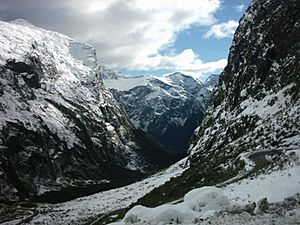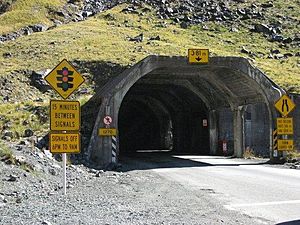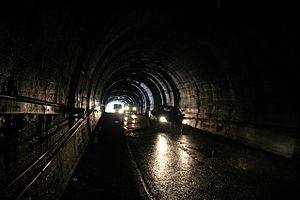Homer Tunnel facts for kids
The Homer Tunnel is a cool road tunnel in the Fiordland area of New Zealand's South Island. It's about 1.2 kilometers (0.75 miles) long and opened in 1953. This tunnel is part of State Highway 94, which connects famous places like Milford Sound to Te Anau and Queenstown. It cuts through the Darran Mountains at a spot called the Homer Saddle. The tunnel links the Hollyford River valley on the east side with the Cleddau River valley on the west.
When it first opened, the tunnel was just one lane and had a gravel road surface. The walls are still natural granite rock. The eastern entrance is high up, at 945 meters (3,100 feet) above sea level. The tunnel slopes downwards for 1,270 meters (4,170 feet) to the western end. Before it was paved and made wider, it was the longest gravel-surfaced tunnel anywhere in the world!
Contents
History of the Homer Tunnel
How the Tunnel Idea Started
The story of the Homer Tunnel began on January 27, 1889. That's when two explorers, William H. Homer and George Barber, discovered the Homer Saddle. William Homer quickly saw that building a tunnel through this saddle would be a great way to reach the beautiful Milford Sound area.
Building the Tunnel: A Big Challenge
Work on the tunnel started in 1935. This happened after a lot of effort from people like J. Cockburn of the Southland Progress League. A rough road was built to the eastern entrance site that same year. The tunnel and the road leading to it were built by workers during the Great Depression. These were tough times, and the workers were part of a "relief" program to help people find jobs.
The project began with just five men, using simple tools like picks and wheelbarrows. Imagine living in tents in a mountainous area where the sun might not shine directly for half the year! The conditions were very difficult. Sadly, at least three workers died in avalanches over the years.
Delays and Completion
Building the tunnel was slow because of the hard conditions. The rock often had cracks, letting water from melting snow pour into the tunnel. To deal with this, special machines were built to pump out a huge amount of water – about 40,000 liters (10,500 gallons) every hour!
Work was also stopped during World War II. Even though the mountain was successfully pierced in 1940, other problems kept the project from finishing. In 1945, a big avalanche destroyed the eastern entrance of the tunnel. All these challenges meant the tunnel wasn't fully finished and opened until 1953.
Safety and Traffic in the Tunnel
Improving Safety Measures
In 2002, a tour bus caught fire inside the Homer Tunnel. Luckily, the passengers and driver were able to get out safely. This event led to important safety improvements. A satellite phone and fire extinguishers were put inside the tunnel.
To make things even safer, roof lighting was added in 2004. Traffic lights were also brought back. These lights help manage the flow of cars and buses.
Managing Traffic Flow
The Homer Tunnel is wide enough for a bus and a smaller car to pass each other. However, it can be tricky when two large vehicles, like two buses or two campervans, meet inside.
To help with this, traffic lights are used. Traffic usually moves mostly towards Milford Sound in the morning and towards Te Anau in the afternoon. The traffic lights only work during the day in the busy summer months. In winter and spring, there's a risk of avalanches, so it's not safe for cars to stop and wait at the tunnel entrances. As more cars use the road, the risk for waiting vehicles might increase.
Future Plans for the Tunnel
There have been talks about making the tunnel wider so that two lanes of traffic could easily pass. This would mean cars wouldn't have to wait in areas where avalanches could happen. However, widening the tunnel would be very expensive. Even though the road is super important for tourism, it doesn't carry a huge amount of traffic compared to other national roads.
There are also good avalanche warning systems in the area. In 2005, there were plans to improve the avalanche shed at the eastern entrance. This project would cost a lot of money, but it would make the tunnel even safer.




